What is The Life Expectancy of a Child With Cerebral Palsy?
Cerebral palsy is a group of permanent disorders that affect a person’s posture, balance, movement, communication, brain function, and ability to perform everyday tasks like sleeping, eating, and learning. Cerebral refers to the brain, whereas palsy refers to muscle weakness. Children with cerebral palsy will typically experience some degree of delayed physical development, often alongside intellectual and learning disabilities.
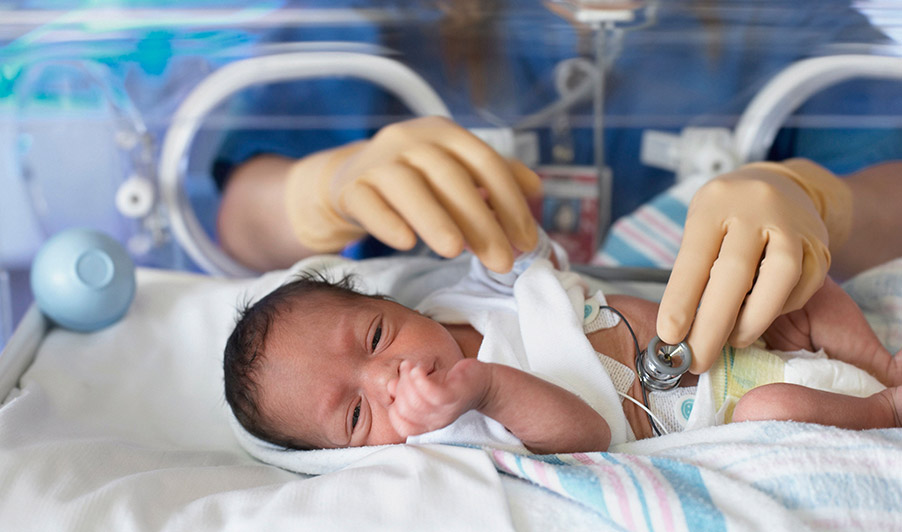
Free Legal Consultation
Cerebral Palsy Lawyers
1-888-987-0005Our dedicated Cerebral Palsy Lawyers are available to meet you in your home or the hospital.
Consequences of cerebral palsy can vary between person to person and not everyone will have the same symptoms or severity in their disabilities. But because of how greatly the condition can impact a child’s everyday life, many parents are naturally concerned about their future. They may wonder:
- Will my child be able to walk someday?
- Will they ever be able to live alone? Will they be able to complete everyday tasks on their own?
- Will my child die prematurely from cerebral palsy?
But perhaps one of the more frightening and existential questions a parent may have is whether cerebral palsy will cut their child’s life short:
Does Cerebral Palsy Affect Life Expectancy?
The short and frustrating answer to this question is yes, but it depends. Cerebral palsy is a complex condition comprised of multiple disorders that vary in intensity.
And while the condition has the capacity to affect one’s lifespan, it is not guaranteed to reduce a child’s life expectancy when their symptoms are mild. And even with moderate or severe symptoms, a child can be expected to live longer when they have access to quality medical care that can reduce the impact of cerebral palsy over the course of their life.
Life expectancy, as the name suggests, refers to the number of years a person can be expected to live. According to mortality data from the Centers for Disease Control (CDC) in 2023, the average life expectancy for the U.S. population was 78.4 years, an increase from the previous year.

Click here to access data table for Figure 1
Children and adults living with cerebral palsy face multiple challenges and related complications that can reduce their life expectancy, including seizures, issues with eating and swallowing, mobility restrictions, and problems with respiratory function.
It’s important to understand that cerebral palsy is not a fatal condition; threats to life expectancy often come from the associated complications of cerebral palsy, not from the condition itself. Many people with milder symptoms of cerebral palsy go on to live fulfilling and independent lives with limited assistance.
However, individuals with more severe cases of cerebral palsy (particularly in cases with advanced paralysis like hemiplegia or quadriplegia) do have a greater risk at living shorter lives because of the associated health conditions they face, especially if they do not have access to high quality medical monitoring and care.

Does Cerebral Palsy Get Worse with Age?
No. While there is currently no known cure for cerebral palsy, the condition is considered “non-progressive,” meaning it does not get worse with age. However, living with cerebral palsy for prolonged periods can lead to more health problems over time, including muscle weakness and joint pain.
In this light, these complications can indirectly make things feel “worse” for people living with cerebral palsy, but the brain damage that causes the condition in the first place never spreads or increases.
What is the Most Common Cause of Death in Cerebral Palsy Patients?

The most common cause of death in cerebral palsy patients is a mix of seizures and respiratory issues. A 2022 research study from the CDC Wide-ranging Online Data for Epidemiologic Research (CDC WONDER) to analyze data of deceased individuals who had cerebral palsy listed as an underlying cause of death.
The study concluded that, of the 25,138 deaths recorded from 1999 to 2019, diseases of the nervous system (epilepsy) and diseases of the respiratory system (pneumonia) were found to be the highest co-occurring secondary causes of death.
How Can Doctors Determine the Severity of Cerebral Palsy?

Several empirical methods have been devised over time to try and quantify cases of cerebral palsy in children. While many different rating scales and systems exist, there are two methods that are generally the most accepted in the medical field:
Gross Motor Function Classification System (GMFCS)
The Gross Motor Function Classification System (GMFCS) was created originally in 1997 by a group of professors from Drexel University and McMaster University. It has been revised and expanded multiple times, most notably in 2007 when it was updated to include testing for children in the 12-18 age bracket.
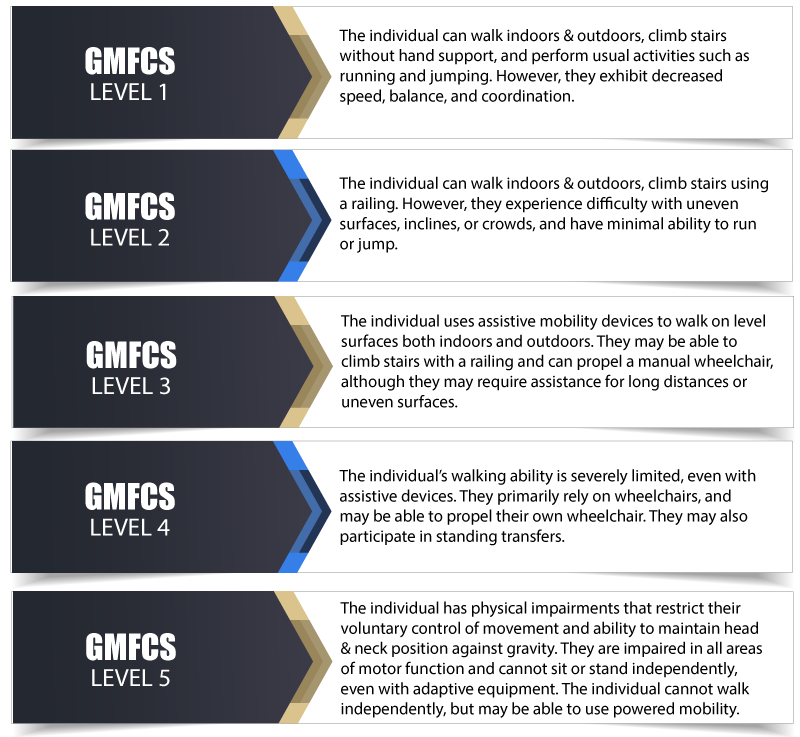
The system is comprised of 5 levels that measure the extent to which a child has control over their motor function and overall mobility. “Gross motor function” refers to the ability to use large muscle groups together to perform movements like standing, walking, running, or bending over.
This is opposed to fine motor skills, which involve using smaller muscles for more precise movements like writing, playing an instrument, or brushing your teeth.
The GMFCS has five levels:
- Level 1: Can walk, climb stairs, run and jump with decreased speed, balance and coordination.
- Level 2: Can walk indoors, climb stairs using a railing, has trouble with uneven surfaces, inclines, or while in crowds.
- Level 3: Walks using assistive mobility devices, may be able to climb stairs using railing, may propel a wheelchair on their own but requires assistance for long distances.
- Level 4: Walking ability is severely limited, even with assistive devices, uses wheelchair for most movement, may participate in standing transfers.
- Level 5: Has physical impairments that restrict voluntary movement control and the ability to maintain head and neck position against gravity, cannot sit nor stand independently, even with adaptive equipment.
The GMFCS scale is the most recognized and accepted assessment score by medical professionals in the United States.
World Health Organization Disability Assessment Schedule 2.0 (WHODAS 2.0)
The World Health Organization Disability Assessment Schedule (WHODAS 2.0) is a comprehensive evaluation outline to measure functioning levels for individuals with disabilities and mental health disorders.
It was created under WHO’s International Classification of Functioning (ICF) framework to provide a standard baseline for describing and measuring health and disability by focusing on a range of domains.
The original version of WHODAS was created in 1988, but it has since undergone multiple updates and revisions over the years. The current version analyzes an individual’s functioning within the following six domains:
- Cognition: Ability to understand and communicate
- Mobility: Ability to move and get around
- Self-Care: Ability to practice hygiene, dressing, eating, and staying alone
- Getting Along: Ability to interact with other people
- Life Activities: Ability to perform domestic responsibilities
- Participation: Ability to join in on community activities
The assessment is relatively easy to administer, taking around 5 to 20 minutes total to complete. Each category is given a score from 0 (no difficulty) to 4 (extreme difficulty). The scores across all categories are summed and converted into a metric ranging from 0 to 100 (0 = No Disability; 100 = Full Disability).
Both the GMFCS and WHODAS 2.0 can give insight into the severity of a child’s cerebral palsy, but doctors and medical professionals may sometimes rely on other frameworks.
In general, though, children who rank higher on these scales (Levels 4 and 5 for GMFCS and scores above 75 on the WHODAS 2.0) are more likely to have a lower life expectancy because of the complications that come from severe cerebral palsy.
What Factors Affect Life Expectancy for People with Cerebral Palsy?
Cerebral palsy itself is not a fatal condition, but there are several associated factors that can threaten a child’s life expectancy. This can include the following:
Type(s) of Cerebral Palsy
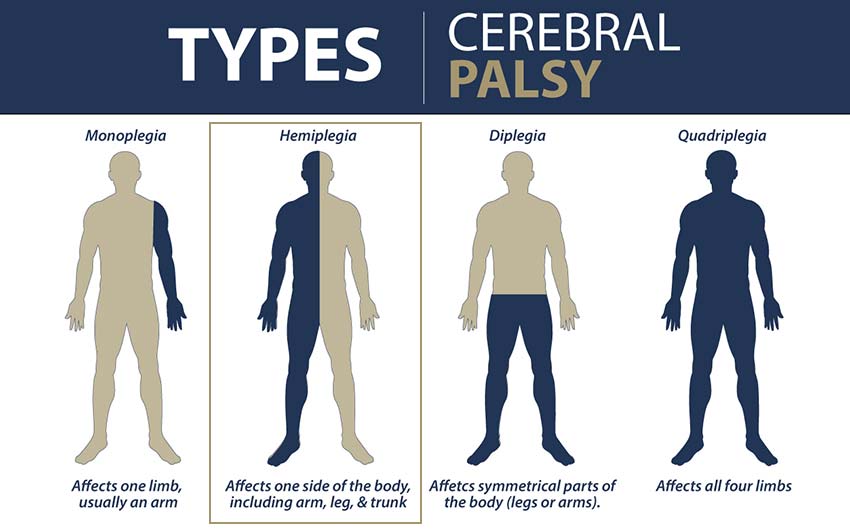
Spastic cerebral palsy is the most common type of cerebral palsy, accounting for roughly 80% of people diagnosed with the condition. People with spastic cerebral palsy exhibit uncontrollable, involuntary limb movements and tight muscles that inhibit movements, causing bone and joint deformities.
Read More
Spastic Cerebral Palsy
Dyskinetic cerebral palsy is the second most common form of cerebral palsy. Research indicates dyskinetic cerebral palsy is caused by “non-progressive lesions to the basal ganglia or thalamus or both.” Frequently, birth trauma due to medical errors during labor and delivery or immediately following birth (called “neonatal negligence”) causes these injuries.
Read More
Dyskinetic Cerebral Palsy
Ataxic cerebral palsy is characterized by issues with balance and coordination. Children with this form of CP might appear unsteady and shaky. Their movements might seem disorganized and jerky to other people.
Read More
Ataxic Cerebral Palsy
When a child displays overlapping symptoms from these different types, they may be diagnosed with mixed cerebral palsy.
The most severe form of cerebral palsy is spastic quadriplegia, a form of spastic cerebral palsy that causes paralysis of all four limbs. Children with mixed cerebral palsy that causes diplegia, hemiplegia, or quadriplegia are at the highest risk for reduced life expectancy.
Mobility Restrictions
Mobility restrictions due to cerebral palsy can cause premature aging and tissue degeneration. Because of their infrequent use, muscles in the legs and arms can weaken and deteriorate over time.
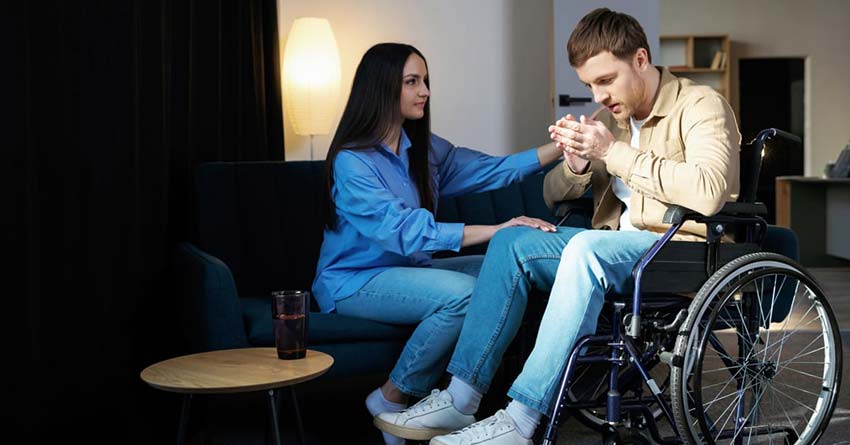
Additionally, prolonged sitting and friction against wheelchairs can put individuals with cerebral palsy at a higher risk for developing pressure sores (also known as bedsores or pressure ulcers).
This is a type of blister-like wound that appears because of repeated friction, moisture, and traction that comes from prolonged immobility. When untreated or improperly treated, it can lead to infections and intense pain.
Feeding Difficulties
Children with cerebral palsy will sometimes have difficulties with chewing, swallowing, and digesting food properly. Sometimes they may require feeding assistance through the use of a G-tube, or they may require someone to manually feed them.
Children with feeding difficulties induced by cerebral palsy are at a higher risk for poor nutrition, dehydration, choking, and suffering from aspiration pneumonia (when food or other foreign materials are inhaled into the lungs). These risks can be fatal and reduce life expectancy when a child’s feeding difficulties are severe enough.
Seizures

The Cerebral Palsy Guide estimates that 30-50% of children with cerebral palsy will experience co-occurring epilepsy. Epilepsy is a neurological disorder that causes recurring, unprovoked seizures.
Seizures can cause a drop in an individual’s blood oxygen levels, which can become deadly if they are prolonged without intervention or treatment.
A child with cerebral palsy and epilepsy who experiences frequent seizures is at risk for a reduced life expectancy because of this.
Cognitive Functioning
When a child’s cerebral palsy severely impacts their cognitive functioning, it results in a higher difficulty in communicating needs and a stronger reliance on others for physical help to meet those needs. This increases the risk for accidental death when those needs are not met, which can impact their life expectancy.
Visual Acuity
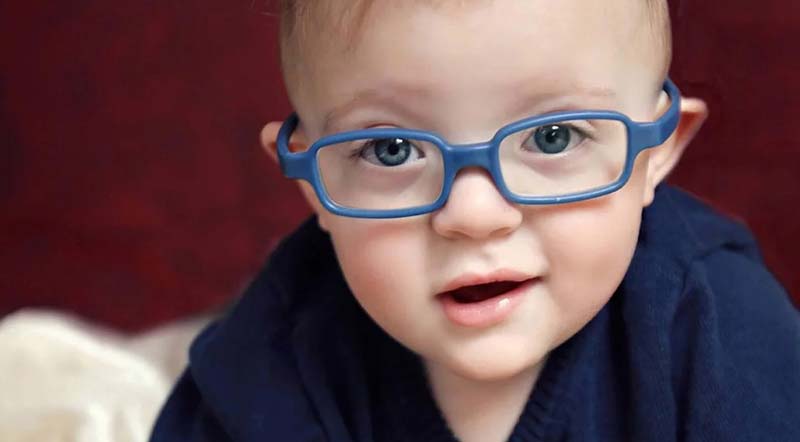
Cerebral palsy has been linked to vision impairments, which can affect a child’s quality of life. Some research has identified an association between visual impairments and mortality, listing it as a factor that can affect an individual’s quality of life.
Respiratory Functioning
Children with cerebral palsy are at a higher risk for respiratory complications and diseases such as aspiration and pneumonia. This is likely due to their restricted mobility, which means they are moving less and develop more shallow breathing due to the inability to frequently exercise and strengthen their lung capacity.
Respiratory problems can also stem from spinal issues like scoliosis, which can reduce the ability of the lungs to expand. These problems are more frequent in children who use wheelchairs.
Respiratory issues are the most common cause of premature death for people with cerebral palsy. If a child is suspected to have issues breathing or is showing signs of a pneumonia infection or aspiration, they must be treated urgently to avoid further complications or death.
How to Manage Cerebral Palsy Conditions?
A 2006 study predicted that children with severe cerebral palsy would have only a 40% chance of surviving to 20 years old. But advancements in medical education and treatment have made that prediction less likely.
With today’s current availability of treatment options, even children diagnosed with severe cerebral palsy have a better prognosis than ever before. The following methods are key to managing cerebral palsy symptoms both mild and severe. When done right, they can improve a child’s life expectancy and, arguably more importantly, their quality of life.
Early Intervention

Starting treatment as early as possible is one of the most critical ways to combat brain injuries. When a child is born with suspected brain damage, there are several treatments and therapies that can be employed in the neonatal intensive care unit, including therapeutic hypothermia and neonatal resuscitation. These treatments can reduce the severity of brain injuries and can potentially limit the severity of a child’s cerebral palsy in the future.
Surgery
Multiple types of surgeries can improve a child’s cerebral palsy complications. A selective dorsal rhizotomy (SDR), for example, can separate specific nerves that transmit messages from muscles to the spinal cord. The surgical team identifies which roots are causing the child’s spasticity and then cuts them, which reduces spasticity.
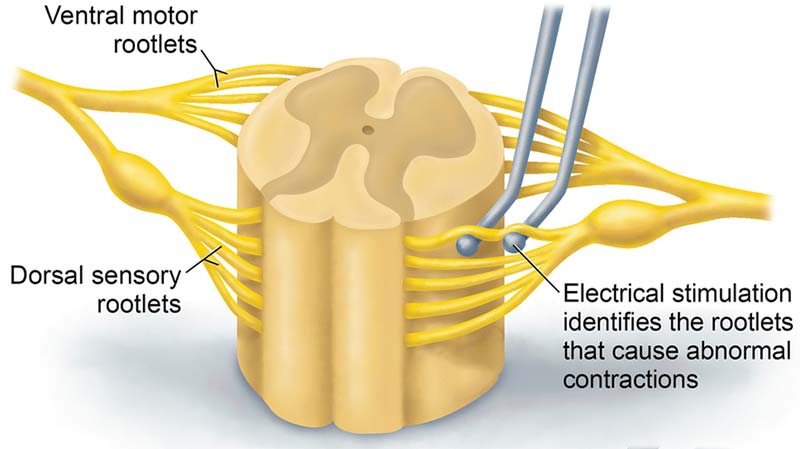
Hip muscle release surgery is a common procedure performed on individuals with cerebral palsy that involves a physician 'releasing' or 'lengthening' muscles in the leg and/or hips to alleviate pain, improve function, and prevent full dislocation.
Hip subluxation is a problem in which the hip becomes partially dislocated. If left untreated, it can result in complete dislocation of the hip and cause significant discomfort and difficulty with mobility.

Other less invasive surgeries can be performed to improve a child’s conditions, such as Cochlear implants to improve hearing or inserting gastronomy tubes to assist with eating.
Newest Treatments
The newest treatments for cerebral palsy include stem cell therapy and botox injections.
Stem cell therapy for cerebral palsy involves injecting stem cells into the brain or spinal cord, which can help repair damaged cells and promote regeneration of neurons.

Stem cells have the remarkable potential to change into different cell types and, in turn, form various tissues. Through a process called differentiation, stem cells can transform from unspecialized cells into specialized types such as heart, lung, or even brain cells.
Stem cell therapy can offer unique benefits to children living with cerebral palsy by replacing the child’s damaged and non-functional brain cells and supporting the remaining cells within the nervous system (neurons and oligodendrocytes cells). While stem cell therapy may not cure cerebral palsy, it can reduce symptoms and increase mobility.
Botox, scientifically known as botulinum toxin, is the name given to an injectable drug made from a highly toxic substance created by the bacterium Clostridium botulinum. This bacteria is found in numerous natural settings, including the intestinal tracts of fish, and can be deadly when ingested.

However, when purified, this toxin can safely be used to effectively reduce muscle spasticity, lessen overly high muscle tone and stiffness, and provide increased mobility to children living with spastic cerebral palsy.
Botox reduces spasticity by weakening or completely paralyzing specific muscles and preventing certain nerves in the body from firing.
Both treatments have proven to provide relief from people’s cerebral palsy symptoms. And while they are not permanent cures, they are worth exploring for severe cases where a child’s symptoms are preventing them from living long and fulfilling lives.
How Can Our Team Can Help Families of Children with Cerebral Palsy?
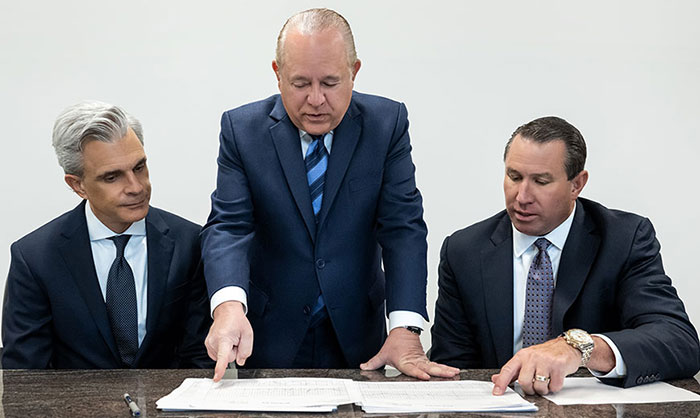
Receiving a child’s cerebral palsy diagnosis can be devastating news for families, especially when it is a severe case. The unfortunate truth is that sometimes medical malpractice can increase the severity of the condition by not taking critical action in the first few moments of life.
This can happen by:
- Delaying critical treatment at birth like neonatal resuscitation or therapeutic hypothermia.
- Failing to diagnose a brain injury at birth.
- Not recommending a child with cerebral palsy to specialists for physical therapy, occupational therapy, or other birth injury treatments that could improve their life expectancy.
- Delaying or failing to provide a child with cerebral palsy access to assistive devices and equipment that could improve their quality of life.
If you believe any of these errors or a different mistake caused harm to your child, schedule a free legal consultation to speak to a specialized birth injury attorney who understands how medical errors can cause or worsen birth injuries.
We believe in holding negligent medical professionals accountable. Our process consists of:
- Discussing your case with you in detail
- Using our extensive resources to investigate your baby's records thoroughly
- Providing nurse-attorneys and nursing staff who understand what has happened medically
- Consulting with experts who understand how you and your child should have been treated
- Seeking compensation for your baby's injuries from the people who caused them
Many birth injury law firms focus only on pursuing their client's legal cases. At Miller Weisbrod Olesky, we know your child needs help today - not just when your birth injury lawsuit is settled. Our team focuses on helping our clients now when they need it most.
We know that children with birth injuries like cerebral palsy often require intense therapy, specialized medical treatment, and assistive care. The stress of providing for a birth-injured child's needs can be both emotionally and financially draining.
But just 'knowing' this is not enough. We act on this knowledge by providing exceptional services to birth-injured children and their families.
Registered Nurses and Nurse-Attorneys Are a Vital Part of Our Birth Injury Team...and Yours

Most birth injury law firms will employ one or two nurses to assist the review of cases and medical research. Miller Weisbrod Olesky offers an unmatched number of nurses and nurse-attorneys to support our clients and dedicated birth injury team.
Our nursing team brings a deep level of medical and personal insight to every client's case. Working closely with the rest of the birth injury legal team, they investigate the reasons behind a birth injury and how medical professionals breached their standard of care...But they do much more.
For our clients, our nurses and nurse-attorneys provide valuable support with medical questions and finding healthcare providers.
While Miller Weisbrod Olesky's birth injury attorneys aggressively prepare each legal case, another department goes into action to help the families of children we represent. We also provide IMMEDIATE help to the families of children we represent while the case is being pursued.
Led by our nurse-attorney, this department acts as a medical case manager for our birth injury clients by:
- Regularly monitoring the child's medical treatment status
- Helping to facilitate medical treatment and therapy
- Arranging transportation and services
Where necessary, we help families locate local medical providers specializing in the care and treatment of children who have suffered a birth injury. With Miller Weisbrod Olesky, you are not 'just a case'. And that's important when you are looking for a lawyer who can help you cope with your child's needs today.
If we feel medical negligence caused or contributed to your child's worsened cerebral palsy, which resulted in an untimely death or reduction in life expectancy, we will meet with you to discuss how you can receive compensation from the medical professionals who made the errors.
At no point in our legal intake process will we ask you to pay anything. The medical review of your case and the consultation are free. We only receive payment when you do. The sooner you reach out to us, the sooner we can begin investigating your case and gathering the evidence needed to support your claim.
We work on a contingency fee basis, meaning you won't pay any legal fees unless we win your case. Contact us today to schedule your free legal consultation by calling our toll-free line at 888-987-0005 or by filling out our online request form.
